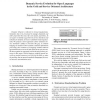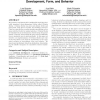43 search results - page 3 / 9 » Emergence of Orienting Behavior in Ecological Neural Network... |
ALIFE
2004
13 years 5 months ago
2004
Turn-taking behavior is simulated in a coupled-agents system. Each agent is modeled as a mobile robot with two wheels. A recurrent neural network is used to produce the motor outpu...
MVA
2007
13 years 6 months ago
2007
This paper presents a recognition method for human behavior identification based on motion history image theory. The motion history image has the advantage that it can record the ...
NN
2008
Springer
13 years 3 months ago
2008
Springer
- This paper describes mechanisms used by humans to stand on moving platforms, such as a bus or ship, and to combine body orientation and motion information from multiple sensors i...
GRID
2004
Springer
13 years 10 months ago
2004
Springer
Dynamic behavior is inherent in virtual organizations. Semantics has to be processed to manage dynamism and other properties like state, life cycle, faults, and others. In our pap...
GECCO
2007
Springer
13 years 11 months ago
2007
Springer
We present a new framework for artificial life involving physically simulated, three-dimensional blocks called Division Blocks. Division Blocks can grow and shrink, divide and fo...


